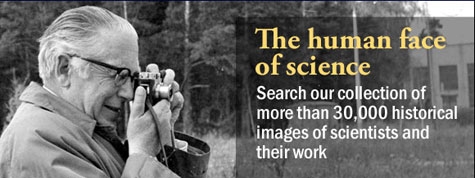Personal photo collections have become ubiquitous over the last few decades. Many of us have even abandoned “real” cameras for the convenience offered by our cell phones to take and store a large amount of images. Nevertheless, managing our voluminous cache to keep only quality images requires time, and the whole exercise is nearly useless without preservation. New technical capabilities in recording for our posterity require new responsibilities to maintain them. Will the most important of our writings and photos currently inscribed onto silicon or magnetic media survive anything like the longevity of Roman era frescoes or medieval era ink on parchment? Dealing with the storage and accessibility problem is one of the key responsibilities of the archival community.

AIP’s Niels Bohr Library and Archives is internationally renowned for preserving historical materials and making them widely accessible. The most popular resource from our archive is the Emilio Segrè Visual Archives (ESVA). Our website for the Segrè collection is one of the most visited sites within the AIP web environment and is used by a wide audience of students, teachers, professionals, and the public. The ESVA now houses over 30,000 images, making it the world’s largest database of visual images pertaining to physics. We have recently revamped this online resource and improved the search tool so that visitors can easily browse images for study, presentations, exhibitions, and publications. ESVA offers free downloads of low-resolution images for classroom use, and modest charges for high-resolution images help to underwrite our services. The new search tool allows users to search by keywords, categories, and dates, and also allows readers to link and aggregate their search results. For frequent users an online account can be set up that will store images previously purchased.
One of the most popular collections of photos in the Segrè Archive is from the Manhattan Project. This collection was bequeathed to us by the Department of Energy in 2007 for our care and stewardship. Other collections of note include the W.F. Meggers Gallery of Nobel Laureates. In 1958, William Meggers donated his collection of photographs of 33 Nobel laureates (many of which were signed), and our archives has since kept this collection current for all winners of the physics prize. Samuel Goudsmit donated more than 300 photos to the archive, along with his papers describing his prolific career as a physicist, editor of Physical Review, and scientific leader of the Alsos mission at the end of World War II to uncover the extent of the Nazi nuclear weapons program. In 2009, Ronald Mickens donated to the archive his collection of photos of African-American physicists, which had its genesis with an important exhibit created by the National Society of Black Physicists. AIP’s Center for History of Physics has a summer team, right now, researching and producing a Teachers Guide on the history of African Americans in the physical sciences. This guide will draw on the Mickens Collection and generally on the Segrè Archive.
The photo archive’s namesake, Emilio Segrè, is best known for his many contributions to nuclear and particle physics, including the Nobel Prize he shared in 1959 with Owen Chamberlain for the discovery of the antiproton. Segrè was also a historian of physics and an amateur photographer. Over 300 of his photos documenting physics and physicists from the 1920s through the 1980s were donated for our stewardship, along with a generous bequest from Segrè’s second wife, Rosa, to support the archives.
